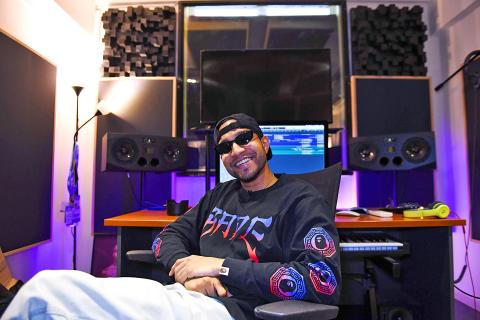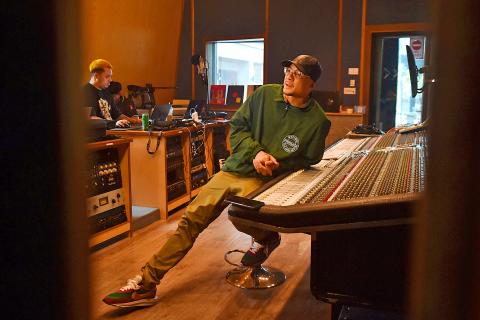When Singapore’s Yung Raja remixed Gucci Gang by US rapper Lil Pump, he swapped the original’s flashy cars and a prowling tiger for a beer can and Tamil food in a viral YouTube video that reeled in hip-hop label Def Jam.
His 2018 version — Poori Gang — was a trial run for the “concoction of Tamil and English” the 24-year-old says defines his flow.
The overnight success, even among non-Tamil speakers in ethnically diverse Singapore, proved to Yung Raja that he could embrace his own identity without copying other Western artists he admired.

Photo: AFP
He is among a growing number of artists from Singapore, Indonesia, Malaysia, Thailand and the Philippines snapped up by the label behind superstars from LL Cool J to Jay-Z and Rihanna.
Def Jam is hoping to capitalize on a new wave of regional rap stars from the untapped Southeast Asian market where streaming platforms are flourishing.
“It’s just exploding,” says Yung Raja, who has drawn comparisons to US superstar Kendrick Lamar.

Photo: AFP
Moving from DIY passion projects to big stage shows, regional rappers are now touring beyond their borders, delivering verses in slick videos streamed online.
‘PUT YOUR HANDS UP’
In a secluded patch of forest on Bangkok’s outskirts, Thai-American DaBoyWay is shooting Baby You.
Bonfires and dancers illustrate verses about being cast under a spell for a track from his new album — out this month — that will be Def Jam’s first major Southeast Asian test.
A pioneer of Thailand’s rap scene, DaBoyWay raps in both Thai and English, in a nod to his US background.
Singles on the album vary from the gritty Gangsh!t to the more club-friendly Kaow Ma, which means “Welcome” in Thai.
The 39-year-old — who now has a million Instagram followers — remembers the early struggles of a genre that rubbed against Thailand’s conservative norms, where fans had to be prodded into letting go at concerts.
“They would not move until you tell them it’s okay to move,” he says at a studio in Chonburi province, near the resort town of Pattaya.
Fast forward to 2018 and popular Thai talent show The Rapper racked up tens of millions of views on YouTube in its first season.
That same year a collective of underground artists known as R.A.D. — or Rap Against Dictatorship — released searing verses criticizing the country’s military that drew well over 60 million views on YouTube.
Fan Pornchai Puthinarabul, who attended a recent DaBoyWay show, credits his “idol” for the genre’s growth in Thailand.
“He’s opened a market for us Thais,” Pornchai said before re-joining concert-goers jammed into a popular Bangkok bar. Asia’s dominant music-streaming platforms like Tencent-owned JOOX have been swift to take notice.
In 2020 its user base reached 290 million in Thailand, Myanmar, Malaysia, Indonesia and Hong Kong, according to company data.
Hip-hop became the second most popular genre, after pop, on JOOX in Thailand late last year.
GAMELANS AND TRAFFIC JAMS
The new roster of rap artists weave heritage, local culture, and their roots into their music.
Asked for his influences Singapore’s Yung Raja ticks off a melange spanning continents, from Canadian artist Drake to famed Indian actor Rajinikanth.
Jakarta-born artist A Nayaka, the first Indonesian rapper signed to Def Jam, has rhymed about the Indonesian capital’s gruelling traffic and other local landmarks in a longstanding hip-hop tradition of name-checking neighborhoods, streets, and communities.
“Basically if Jakarta kids heard my lyrics they’re gonna say, ‘oh my god, that’s that,’” he says.
The diversity of Southeast Asia — with dozens of languages, religions, cultures and ethnicities — is its strength, according to Joe Flizzow, a Malaysian considered the godfather of the region’s rap scene and a Def Jam executive.
Whether snatching samples from the traditional gamelan — a brass glockenspiel-like instrument — or with lyrics touching on corruption and oppression, artists are representing their origins in different ways.
“You are not going to see some Bentleys and Rolls Royces,” he says. “You are gonna see some Honda NSXs and GTRs... we want to be unique.”

That US assistance was a model for Taiwan’s spectacular development success was early recognized by policymakers and analysts. In a report to the US Congress for the fiscal year 1962, former President John F. Kennedy noted Taiwan’s “rapid economic growth,” was “producing a substantial net gain in living.” Kennedy had a stake in Taiwan’s achievements and the US’ official development assistance (ODA) in general: In September 1961, his entreaty to make the 1960s a “decade of development,” and an accompanying proposal for dedicated legislation to this end, had been formalized by congressional passage of the Foreign Assistance Act. Two

Despite the intense sunshine, we were hardly breaking a sweat as we cruised along the flat, dedicated bike lane, well protected from the heat by a canopy of trees. The electric assist on the bikes likely made a difference, too. Far removed from the bustle and noise of the Taichung traffic, we admired the serene rural scenery, making our way over rivers, alongside rice paddies and through pear orchards. Our route for the day covered two bike paths that connect in Fengyuan District (豐原) and are best done together. The Hou-Feng Bike Path (后豐鐵馬道) runs southward from Houli District (后里) while the

March 31 to April 6 On May 13, 1950, National Taiwan University Hospital otolaryngologist Su You-peng (蘇友鵬) was summoned to the director’s office. He thought someone had complained about him practicing the violin at night, but when he entered the room, he knew something was terribly wrong. He saw several burly men who appeared to be government secret agents, and three other resident doctors: internist Hsu Chiang (許強), dermatologist Hu Pao-chen (胡寶珍) and ophthalmologist Hu Hsin-lin (胡鑫麟). They were handcuffed, herded onto two jeeps and taken to the Secrecy Bureau (保密局) for questioning. Su was still in his doctor’s robes at

Mirror mirror on the wall, what’s the fairest Disney live-action remake of them all? Wait, mirror. Hold on a second. Maybe choosing from the likes of Alice in Wonderland (2010), Mulan (2020) and The Lion King (2019) isn’t such a good idea. Mirror, on second thought, what’s on Netflix? Even the most devoted fans would have to acknowledge that these have not been the most illustrious illustrations of Disney magic. At their best (Pete’s Dragon? Cinderella?) they breathe life into old classics that could use a little updating. At their worst, well, blue Will Smith. Given the rapacious rate of remakes in modern